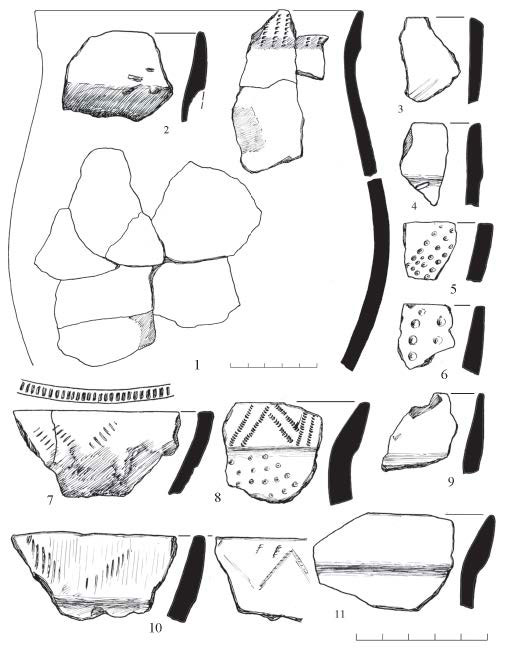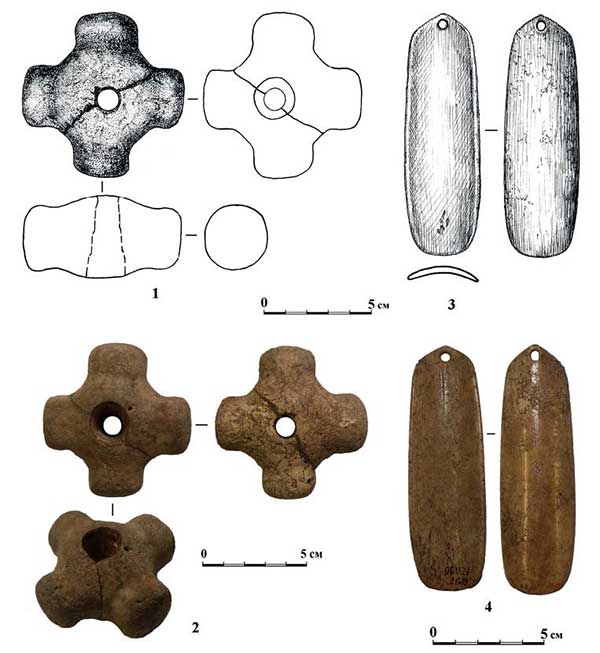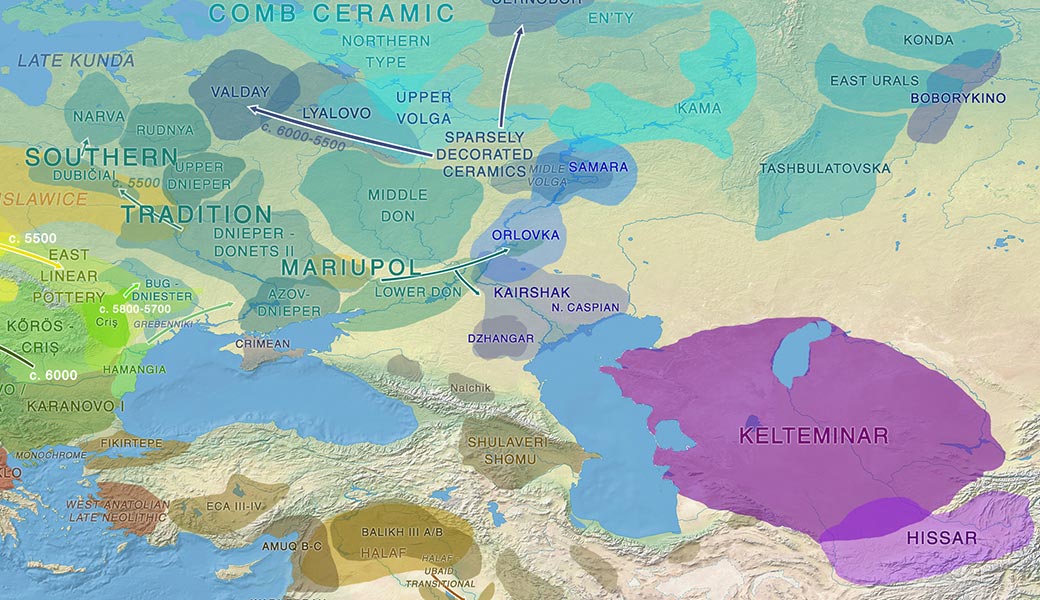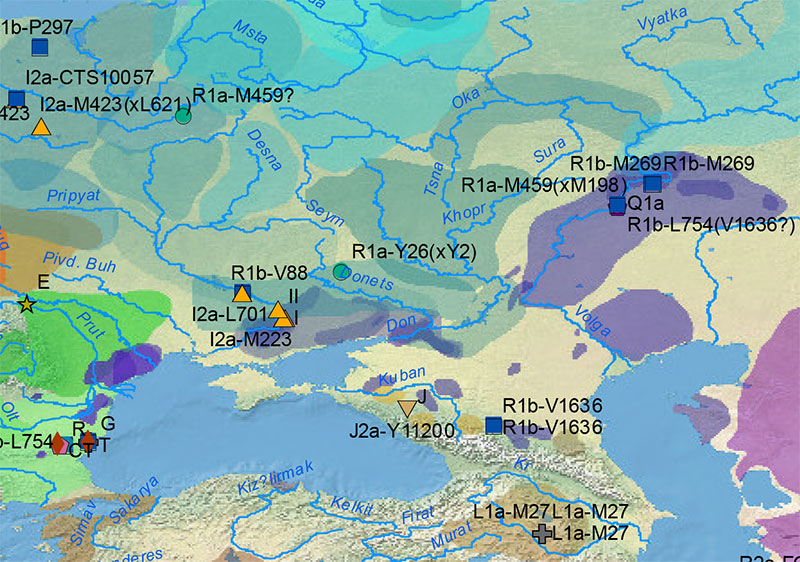We already had conflicting information about the elite individual from the Yekaterinovsky Cape and the materials of his grave, which seemed quite old:
For the burial of 45 in the laboratory of the University of Pennsylvania, a 14C date was obtained: PSUAMS-2880 (Sample ID 16068)> 30 kDa gelatin Russia. 12, Ekaterinovka Grave 45 14C age (BP) 6325 ± 25 δ 13C (‰) –23.6 δ15 N (‰) 14.5. The results of dating suggest chronological proximity with typologically close materials from Yasinovatsky and Nikolsky burial grounds (Telegini et al. 2001: 126). The date obtained also precedes the existing dates for the Khvalynsk culture (Morgunova 2009: 14–15), which, given the dominance of Mariupol traits of the burial rite and inventory, confirms its validity. However, the date obtained for human bones does not exclude the possibility of a “reservoir effect” when the age can increase three or more centuries (Shishlin et al. 2006: 135–140).
Now the same date is being confirmed by the latest study published on the site, by Korolev, Kochkina, and Stachenkov (2019) and it seems it is really going to be old. Abstract (in part the official one, in part newly translated for clarity):
For the first time, pottery of the Early Eneolithic burial ground Ekaterinovsky Cape is published. Ceramics were predominantly located on the sacrificial sites in the form of compact clusters of fragments. As a rule, such clusters were located above the burials, sometimes over the burials, some were sprinkled with ocher. The authors have identified more than 70 vessels, some of which have been partially reconstructed. Ceramic was made with inclusion of the crushed shell into molding mass. The rims of vessels had the thickened «collar»; the bottoms had a rounded shape. The ornament was located on the rims and the upper part of the potteries. Fully decorated vessels are rare. The vessels are ornamented with prints of comb and rope stamps, with small pits. A particularity of ceramics ornamentation is presented by the imprints of soft stamps (leather?) or traces of leather form for the making of vessels. The ornamentation, made up of «walking comb» and incised lines, was used rarely as well as the belts of pits made decoration under «collar» of a rim. Some features of the ceramics decoration under study relate it with ceramics of the Khvalynsk culture. The ceramics of Ekaterinovsky Cape burial ground is attributed by the authors to the Samara culture. The ceramic complex under study has proximity to the ceramics from Syezzhe burial ground and the ceramics of the second phase of Samara culture. The chronological position is determined by the authors as a later period than the ceramics from the Syezzhe burial ground, and earlier than the chronological position of ceramics of the Ivanovka stage of the Samara culture and the Khvalynsk culture.

More specifically:
Based on ceramic fragments from a large vessel from a cluster of sq.m. 14, the date received was: SPb-2251–5673 ± 120 BP. The second date was obtained in fragments from the aggregation [see picture above] from the cluster of sq.m. 45–46: SPb-2252–6372 ± 100 BP. The difference in dating indicates that the process of determining the chronology of the burial ground is far from complete, although we note that the earlier date almost coincided with the date obtained from the human bone from individual 45 (Korolev, Kochkina, Stashenkov, 2018, p. 300).
Therefore, the ceramics of the burial ground Ekaterinovsky Cape possess an originality that determines the chronological position of the burial ground between the earliest materials of the burial type in Syezzhe and the Khvalynsk culture. Techno-typological features of dishes make it possible to attribute it to the Samara culture at the stage preceding the appearance of Ivanovska-Khvalynsk ceramics.
It seems that this site showed cultural influences from the upstream region near the Kama-Vyatka interfluve, too, according to Korolev, Kochkina, Stashenkov, and Khokhlov (2018):
In 2017, excavation of burial ground Ekaterinovsky Cape were continued, located in the area of the confl uence of the Bezenchuk River in the Volga River. During the new excavations, 14 burials were studied. The skeleton of the buried were in a position elongated on the back, less often – crooked on the back with knees bent at the knees. In one burial (No. 90), a special position of the skeleton was recorded. In the burial number 90 in the anatomical order, parts of the male skeleton. This gave grounds for the reconstruction of his original position in a semi-sitting position with the support of elbows on the bottom of the pit. Noteworthy inventory: on the pelvic bones on the left lay a bone spoon, near the right humerus, the pommel of a cruciform club was found. A conclusion is made about the high social status of the buried. The results of the analysis of the burial allow us to outline the closest circle of analogies in the materials of Khvalynsky I and Murzikhinsky burial grounds.
Important sites mentioned in both papers and in this text:
To sum up, it seems that the relative dates we have used until now have to be corrected: older Khvalynsk I Khvalynsk II individuals, supposedly dated ca. 5200-4000 BC (most likely after 4700 BC), and younger Yekaterinovsky individuals, supposedly of the fourth quarter of the 5th millennium (ca. 4250-4000 BC), are possibly to be considered, in fact, roughly reversed, if not chronologically, at least culturally speaking.
Interestingly, this gives a new perspective to the presence of a rare fish- or reptile-headed pommel-scepter, which would be natural in a variable period of expansion of the horse and horse-related symbolism, a cultural trait rooted in the Samara culture attested in Syezzhe before the unification of the symbol of power under the ubiquitous Khvalynsk-Suvorovo horse-headed scepters and related materials.

The Khvalynsk chieftain
If the reported lineages from Yekaterinovsky Cape are within the R1b-P297 tree, but without further clades, as Yleaf comparisons may suggest, there is not much change to what we have, and R1b-M269 could actually represent a part of the local population, but also incomers from the south (e.g. the north Caspian steppe hunter-gatherers like Kairshak), the east (with hunter-gatherer pottery), or the west near the Don River (in contact with Mariupol-related cultures, as the authors inferred initially from material culture).
Just like R1a-M417 became incorporated into the Sredni Stog groups after the Novodanilovka-Suvorovo expansion, probably as incoming hunter-gatherer pottery groups from the north admixing with peoples of “Steppe ancestry”, R1b-M269 lineages might have expanded explosively only during the Repin expansion, and maybe (like R1b-L51 later) they formed just a tiny part of the clans that dominated the steppe during the Khvalynsk-Novodanilovka community.
On the other hand, the potential finding of various R1b-M269/L23 samples in Yekaterinovsky Cape (including an elite individual) would suggest now, as it was supported in the original report by Mathieson et al. (2015), that these ancient R1b lineages found in the Volga – Ural region are in fact most likely all R1b-M269 without enough coverage to obtain proper SNP calls, which would simplify the picture of Neolithic expansions (yet again). From the supplementary materials:
10122 / SVP35 (grave 12). Male (confirmed genetically), age 20-30, positioned on his back with raised knees, with 293 copper artifacts, mostly beads, amounting to 80% of the copper objects in the combined cemeteries of Khvalynsk I and II. Probably a high-status individual, his Y-chromosome haplotype, R1b1, also characterized the high-status individuals buried under kurgans in later Yamnaya graves in this region, so he could be regarded as a founder of an elite group of patrilineally related families. His MtDNA haplotype H2a1 is unique in the Samara series.

This remarkable Khvalynsk chieftain, whose rich assemblage may correspond to the period of domination of the culture all over the Pontic-Caspian steppes, has been consistently reported as of hg. R1b-L754 in all publications, including Wang et al. (2018/2019) tentative SNP calls in the supplementary materials (obtained with Yleaf, as the infamous Narasimhan et al. 2018 samples), but has been variously reported by amateurs as within the R1b-M73, R1b-V88, or (lately) R1b-V1636 trees, which makes it unlikely that quality of the sample is allowing for a proper SNP call.
The fact that Mathieson et al. (2015) considered it a member of the R1b-M269 clans appearing later in Yamna seems on point right now, especially if samples from Yekaterinovka are all within this tree. The relevance of R1b-L23 in the expansion of Repin and Yamna is reminiscent of the influence of successful clans among Yamna offshoots, such as Bell Beakers, and among Bell Beaker offshoots during the Bronze Age all over Europe.
Taking these younger expansions as example, it seems quite likely based on cultural links that (at least part of) the main clans of Khvalynsk were of R1b-M269 lineage, stemming from a R1b-dominated Samara culture, in line with the known succeeding expansions and the expected strictly patriarcal and patrilineal society of Proto-Indo-Europeans, which would have exacerbated the usual reduction in Y-chromosome haplogroup variability that happens during population expansions, and the aversion towards foreign groups while the culture lasted.

The finding of R1b-L23 in Yekaterinovka, associated with the Samara culture, before or during the Khvalynsk expansion, and close to the Khvalynsk site, would make this Khvalynsk chieftain most likely a member of the M269 tree (paradoxically, the only R1b-L754 branch amateurs have not yet reported for it). Similarly, the sample of a “Samara hunter-gatherer” of Lebyazhinka, of hg. R1b-P297, could also be under this tree, just like most R1b-M269 from Yamna are downstream from R1b-L23, and most reported R1b-M269 or R1b-L23 from Bell Beakers are under R1b-L151.
On the other hand, we know of the shortcomings of attributing a haplogroup expansion to the best known rulers, such as the famous lineages previously wrongly attributed to Niall of the Nine Hostages or Genghis Khan. The known presence of R1b-V1636 up to modern Greeks would be in line with an ancient steppe expansion that we know will show up during the Neolithic, although it could also be a sign of a more recent migration from the Caucasus. The presence of a sister clade of R1b-L23, R1b-PF7562, among modern Balkan populations, may also be attributed to a pre-Yamna steppe expansion.

On SNP calls
I reckon that even informal reports on SNP calls, like any other analyses, should be offered in full: not only with a personal or automatic estimation of the result, but with a detailed explanation of the good, dubious, and bad calls, alternatives to that SNP estimation, and a motivated reasoning of why one branch should be preferred over others. Downloading a sample and giving an instruction using a free software tool is never enough, as it became crystal clear recently for the hilariously biased and flawed qpAdm reports on Dutch Bell Beakers as the ‘missing link’ between Corded Ware and Bell Beakers…
Another example I can recall is the report of a R1a-Z93 subclade in the R1a-M417 sample ca. 4000 BC from Alexandria, which seems rather unlikely, seeing how this subclade must have split and expanded explosively with R1a-Z645 to the east with eastern Corded Ware groups, i.e. 1,000 years later, just like Z282 lineages expanded mainly to the north-east. But then again, as with the Khvalynsk chieftain, I have only seen indirect reports of that supposed SNP (including Y26+!), so we should just stick with its officially reported R1a-M417 lineage. This upstream haplogroup was, in fact, repeated with Yleaf’s tentative estimates in Wang et al. (2019) supplementary materials…
The combination of inexperienced, biased, or simply careless design, analyses, and reports, including SNP calls and qpAdm analyses (whether in forums or publications), however well-intentioned (or not) they might be, are hindering a proper analysis of data, adding to the difficulties we already have due to the scarcity of samples, their limited coverage, and the lack of proper context.
Some people like to repeat ad nauseam that archaeology and/or linguistics are ‘not science’ whenever they don’t fit their beliefs and myths based on haplogroup and/or ancestry. But it’s becoming harder and harder to rely on certain genetic data, too, and on their infinite changing interpretations, much more than it is to rely on linguistic and archaeological research, including data, assessments, and discussions that are open for anyone to review…if one is truly interested in them.